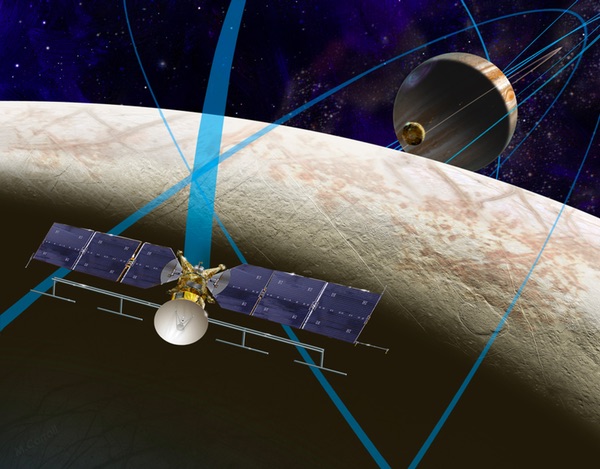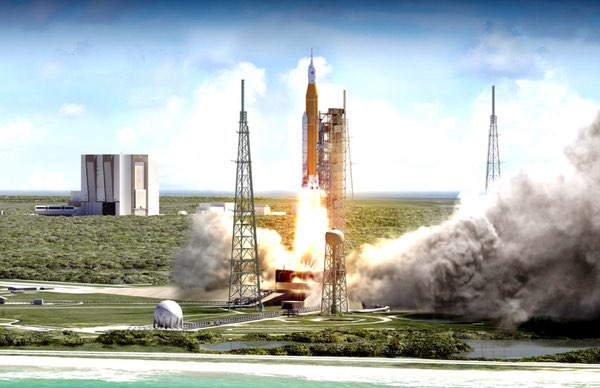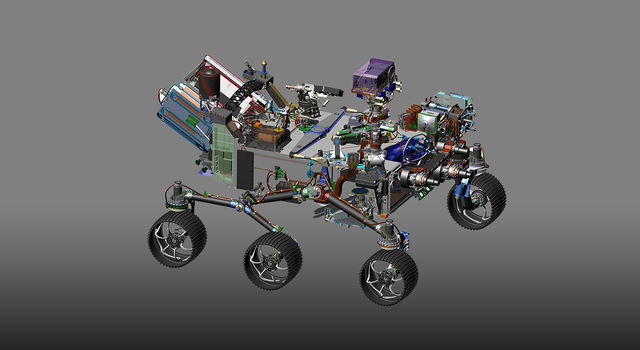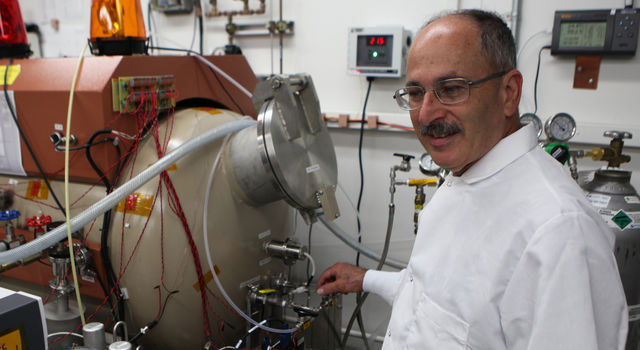
A NASA mission to make repeated flybys of Europa would likely be the precursor for a lander mission, with both planned to launch on the SLS as directed by Congress. (credit: NASA/JPL)
|
Two SLS to Jupiter
The motivations and ramifications of the Europa mission’s launch vehicle mandate
by Cody Knipfer
Monday, July 11, 2016

Europa, the icy Jovian moon with a subsurface liquid water ocean heated by tidal forces, presents a tremendous opportunity for scientific exploration and offers tantalizing possibilities for the search for extraterrestrial life. Despite the stark warning issued in Arthur C. Clarke’s 2010: Odyssey Two to “attempt no landing there,” NASA has been working on a dedicated mission to Europa, which now involves a lander, for more than three years.
This mission’s profile has undergone considerable evolution since Congress first allocated money in 2013 to finance it, including a policy mandate to utilize the heavy-lift Space Launch System for launch.
The SLS mandate
Early Europa plans called for an orbiter which would conduct surveys while making multiple flybys of the moon. Project officials were exploring potential options for launch aboard a variety of rockets. Then, the 2016 Consolidated Appropriation Act, the omnibus spending bill that funded the federal government for the current fiscal year, specified that the mission must “include an orbiter with a lander that will include competitively selected instruments.” Moreover, the act stated that NASA must “use the Space Launch System as the launch vehicle for the Jupiter Europa mission.”
Following this mandate, the Government Accountability Office (GAO) expressed concern that NASA, directed to include a lander in the mission, did not have the resources to meet its target 2022 launch date.
| The possibility that two SLS launches will take place to support the Europa mission now appears likely. |
In response, the House Appropriations Committee’s commerce, justice, and science spending bill for fiscal year 2017 splits the mission through two launches: the orbiter in 2022 and the lander in 2024. According to the bill’s draft report, NASA will need to “ensure that future funding requests are consistent with achieving a Europa Orbiter launch no later than 2022 and a Europa Lander launch no later than 2024, pending final mission configuration.” NASA will also need to “submit long-term plans for maximizing the use of the SLS. NASA shall include the Europa Orbiter and Lander missions in this plan.”
Though significant changes to this policy could occur as the fiscal year 2017 appropriations process continues, the possibility that two SLS launches will take place to support the Europa mission now appears likely.
This mission is unique in being one of the very few NASA science missions, if not the only, to have a launch vehicle selected through Congressional mandate. What factor—scientific, technical, and political—influenced this policy decision? What are some potential financial and programmatic ramifications of this launch mandate?
Scientific and technical motivations
Though political motivations surely influence policymakers to find missions for the Space Launch System, scientific and technical considerations have been among the leading justifications issued for its use in the Europa mission.
John Grunsfeld, who recently retired as NASA’s associate administrator for science, said in a 2014 NASA SLS article that “the potential use of SLS for science will further enhance the synergy between scientific exploration and human exploration… SLS has the promise of enabling transformational science in our exploration of the solar system and cosmos.” Steve Creech, the Assistant Program Manager for Strategy and Partnerships for SLS, argued that “for missions to the outer planets… SLS could make it possible to do things that are currently impossible, such as sending larger scientific spacecraft with more instruments to far off destinations with reduced transit times.” NASA Advanced Concepts Office Manager Reggie Alexander mirrored that view, saying that “the Space Launch System could be really game-changing for space science. For some missions, it makes it much easier and quicker to carry them out.”
A Boeing study, presented at the 46th Lunar and Planetary Science Conference in 2015, concluded that “SLS performance enables larger payloads and faster travel times with reduced operational complexity when compared to original concept studies.” With regard to the Europa mission in particular, the SLS provides “sufficient launch mass margin allowing for increased radiation shielding mass as well as expansion of the science payload.”
According to the study, use of the SLS instead of an Atlas V would allow for a direct ballistic approach instead of a Venus-Earth-Earth gravity assist, shortening transit time to Jupiter by more than four years.
There is benefit in an increased mass margin and shortened transit time to Jupiter. It makes possible a larger scientific payload aboard the mission’s spacecraft. The possibility for increased radiation shielding is also attractive; the harsh radiation environment around Jupiter is challenging for scientists working on the instruments that must survive it, and has been listed as among the mission’s top risks.
| A shortened transit time more readily satisfies basic human nature: scientists, policymakers, space enthusiasts, and the general public would like to see discoveries and results sooner rather than later. |
Shortened transit time reduces the costs, however marginal they may be, of funding and sustaining the mission’s science and support teams as well as support infrastructure during flight enroute to Jupiter. To that, Grunsfeld has said that “this is one of those rare cases where time really is money… in that extra cruise time, we have to maintain an engineering team and a science team and a spacecraft while it's in cruise, even if we hibernate.”
Eliminating the need for gravity assist reduces flight risk and the mission’s complexity—and, accordingly, the effort and resources necessary for planning and executing such maneuvers. Finally, a shortened transit time more readily satisfies basic human nature: scientists, policymakers, space enthusiasts, and the general public would like to see discoveries and results sooner rather than later. The earlier the Europa mission can return valuable data, the sooner scientists can analyze and draw conclusions from it. NASA, mission planners, and Congress can develop follow-on missions sooner, and the public will feel they’ve gained a return on investment into their civil space program.
Political motivations
Yet, while these scientific and technical justifications would’ve undoubtedly come into consideration had the choice of launch vehicle been NASA’s to make, the decision to use SLS was congressional. The SLS launch mandate is an inherently political decision.
Indeed, the Europa effort as a whole has been stimulated primarily by political pressure. While NASA has only tepidly sought funds for the mission, requesting $45 million in Europa funding between fiscal years 2013 and 2016, Congress has significantly increased funding for it, appropriating $395 million through those years. The draft fiscal year 2017 appropriations bill in the House proposes $260 million for Europa mission planning and development, though NASA’s request was only $49.6 million.
This Congressional pressure is due largely to the efforts of Rep. John Culberson (R-TX), chairman of the House Appropriations Committee’s commerce, justice, and science (CJS) subcommittee and a staunch advocate of a Europa mission. Culberson, a vocal supporter of NASA’s planetary science effort and associated search for extraterrestrial life, believes that “the first place we will discover life on another world is Europa. It will be discovered in the oceans of Europa.” Europa, in his view, “had no advocate, until now,” and with him at the helm of the CJS appropriations subcommittee, Congress has allocated additional funding directed at a dedicated mission. Culberson believes such an effort “needs to be a flagship mission. The biggest and best we’ve ever flown.”
Notably, Culberson has said that “we will need the heavy lift capability of the [Space Launch System] rocket for all of those [outer planet] missions.”
| Assuming that EM-2 flies in 2021 or 2023, the 2022 and 2024 Europa mission launches would satisfy the “necessary requirement” of one SLS flight per year. |
The rocket is a centerpiece of NASA’s strategy for a campaign of crewed Mars missions, advertised as the “Journey to Mars.” This campaign has political buy-in, with the NASA Authorization Act of 2010 declaring that a “long term objective for human exploration of space should be the eventual international exploration of Mars,” and the National Space Policy of 2010 calling for NASA to “begin crewed missions beyond the moon, including sending humans to an asteroid” and “by the mid-2030s, send humans to orbit Mars and return them safely to Earth.”
The first SLS launch—EM-1, which will lob an uncrewed Orion capsule to orbit around the Moon—is on track to occur in 2018. The following mission – the crewed EM-2 flight – has a “no later than 2023” launch date assigned to it, with the expectation that it will launch in the 2021–2023 timeframe. This leaves a gap of three to five years between the first and second SLS flights, a far cry from the “necessary requirement” of a SLS launch at least once a year.
In light of these converging factors—NASA’s inability to meet a 2022 launch date for a combined Europa orbiter and lander, reasonable scientific and technical arguments for launch aboard the SLS, and unsettled concerns about the SLS’s short-term launch cadence—Congress is contemplating splitting the mission into two launches. Assuming that EM-2 flies in 2021 or 2023, the 2022 and 2024 Europa mission launches would satisfy the “necessary requirement” of one SLS flight per year.
If such is the case, SLS’s backers in the political arena could find reason to sustain their support for and financing of the program, NASA could answer critics’ concerns about the rocket’s launch cadence, and the “Journey to Mars” could have one of its architecture uncertainties crossed off the list, at least for the short term.
Hence, the unorthodox decision to congressionally mandate a particular launch vehicle for a NASA science mission.

Launching two Europa spacecraft could help fill gaps in the SLS manifest of crewed exploration missions, but at what cost to NASA? (credit: NASA)
|
Ramifications
The SLS mandate and the potential for two launches are not insignificant, with multiple programmatic and financial ramifications emerging as a result.
| To meet the targeted 2022 and 2024 launch dates, the Europa mission might crowd out funding for other planetary and Earth science programs. |
These could complicate the mission planning effort, risking schedule slippage and possible cost overruns, as launch vehicle compatibility influences and impacts spacecraft design. In March 2018, when the Europa project holds its planned preliminary design review—the point when projects tend to select a launch vehicle—the SLS will still be in development. NASA officials “have said they would be willing to delay launch vehicle selection and maintain spacecraft compatibility with both launch vehicle options [SLS and Atlas V] for 8 months until the SLS’s committed launch readiness date of November 2018.”
At the time the 2016 Consolidated Appropriation Act’s became law, the Europa mission team had made significant progress in developing the orbiter’s mission profile and had selected nine scientific instruments for the spacecraft. According to the aforementioned GAO report, the addition of a lander and the SLS launch mandate requires NASA to revise those plans. Project officials have stated that a lander will increase the mission’s costs and development schedule. The effect of this addition will soon be known, as the project plans to enter the preliminary design and technology completion phase—at which point a range of expected costs and schedule will be established—this month.
As previously mentioned, launch aboard the SLS, especially aboard two SLS vehicles, presents possibilities for mission planners. The SLS’s greater capability compared to an Atlas V allows for increased radiation shielding aboard both the orbiter and the lander, something that, at the time of the GAO report, NASA was considering. With room on each SLS for additional payload mass, project officials can consider extending the scientific scope and scale of the mission. Of course, an expanded scientific payload is contingent upon mission funding.
This issue of funding, especially in light of the SLS mandate, is crucial. The likely cost of the mission, not including launch, has been estimated by various sources in the range of $2–3 billion. The GAO suggested the mission could cost upwards of $3–4 billion. The draft CJS 2017 appropriations bill specifies that NASA’s fiscal year 2018 budget proposal provide a five-year funding profile to support the mission and its two launches.
To meet the targeted 2022 and 2024 launch dates, the Europa mission might crowd out funding for other planetary and Earth science programs. Such concerns were raised during the drafting of the 2016 spending bill, with Shaun Donovan, Director of the Office of Management and Budget, writing that “while directing an impractical level of funding toward the Jupiter Europa mission, the bill cuts important NASA Science programs by more than $200 million compared to the President’s Budget.” (See “What price Europa?”, The Space Review, June 1, 2015)
NASA’s fiscal year 2017 budget request included similar concerns. It featured a funding profile supporting a 2022 launch that would require spending $194 million in 2017, increasing to $678 million a year by 2020. Still, the request stated that “acceleration of the launch to 2022 is not recommended, given potential impacts to the rest of the Science portfolio.” And, as David Radzanowski, NASA’s chief financial officer, noted, that funding profile didn’t include a lander since its cost is still being evaluated.
Meeting the targeted launch dates while satisfying that congressional mandate will require Congress to substantially increase the planetary science budget over the coming years, lest NASA’s broader mission portfolio be jeopardized. This will depend, though, on the Office of Management and Budget (OMB) accepting the new plan and allowing NASA to sign multi-year contracts with its vendors. So far, OMB has been hesitant to prioritize the planetary science budget so as to accommodate the Europa mission.
Then comes the issue of financing the SLS launch. Each SLS launch will cost, as a conservative estimate, between $500 million and $1 billion, if not more, on top of the mission’s other costs.
| The choice of SLS for launch should, like every other science mission launched, be NASA’s to make, following a careful internal consideration of the agency’s broad portfolio, priorities, and need for resource distribution. |
Either Congress will substantially increase NASA’s budget to finance the construction and launch of these SLS vehicles, or the launches will require NASA to reallocate significant funds from other parts of its budget. To assume the former is, considering the precedent of historical and contemporary funding levels, misguided optimism, while the later presents a troubling situation where NASA must decide to either scale back its science efforts or prolong development of the “Journey to Mars” even further. Considering that the first half of the 2020s is when much of the technological development for a Mars campaign—deep space habitats, solar electric propulsion, in-situ resource utilization capability—will be at least in their early stages and this require significant funding, this is a troubling possibility indeed.
A lingering concern
There exists a further, if perhaps unsubstantiated, concern about the SLS launch mandate. Many within the space policy community have a lingering, if not often spoken, suspicion that the SLS program may not survive in current form and scale after the next administration takes office.
If, for reasons of funding, broad programmatic or policy change, or some other set of circumstances, there is a sizable delay in the SLS’s capacity or capability to fly, will the Europa project be able to switch launch vehicles? If so, this would likely force a redesign of the mission, additional costs, and delays which run risk of missing the mandated launch date.
This concern may well prove inconsequential, yet is among the questions that emerge from mandating a flight aboard a vehicle which has not yet flown.
The author’s perspective
As with Rep. Culberson, the author believes a research mission to Europa presents a tremendously exciting opportunity for our exploration of the universe. As he said in one interview, Culberson “make sure you and I are here to see those first tube worms and lobsters on Europa,” or, if the movie Europa Report is to be believed, man-eating octopi. Regardless of the form of life to be found in Europa, if any is to be found at all, a flagship mission to the moon represents what NASA does best: pioneering exploration efforts to places which offer tantalizing possibilities for discovery.
A policy directive to launch the Europa mission aboard the SLS is antithetical to the obligations he lays out. Directing NASA to utilize a specific vehicle is, in effect, Congress playing engineer. Considering the costs associated with one SLS launch, let alone two, hard-earned tax dollars will be spent far less wisely and frugally than they would if other readily available options, such as an Atlas V, or options bound to come online before the mission’s preliminary design review, such as a Falcon Heavy, were utilized.
This is not to say that the SLS can’t be the optimal launch vehicle for the Europa mission. It may well be that, at the end of the day, the benefits borne from SLS’s capabilities, as laid out by NASA leadership, outweigh the costs associated with its launch; and that Congress allocates adequate finances to support the project as mandated without jeopardizing other parts of NASA’s mission.
Yet the choice of SLS for launch should, like every other science mission launched, be NASA’s to make, following a careful internal consideration of the agency’s broad portfolio, priorities, and need for resource distribution. If the historical and contemporary precedent of agency funding levels and policy instability counts for much, anything otherwise is a risky proposition.
Culberson’s advocacy for and passion about a Europa mission is highly commendable; the exploration of outer space indeed needs more staunch advocates. Yet, with the SLS launch mandate, Congress is playing politics with planetary science, risking other opportunities for groundbreaking discovery by forcing launch aboard another politically-motivated, highly expensive program with no guarantee of the increased funding needed to support it.
The Congressman is right. This is one of the biggest problems NASA’s got.
Cody Knipfer ( CodyKnipfer@gmail.com) is an Associate at PoliSpace, a DC-based space policy consultancy, and a Masters student at George Washington University’s Space Policy Institute. Except for quotes, the views and opinions expressed herein are the author’s own. | 






